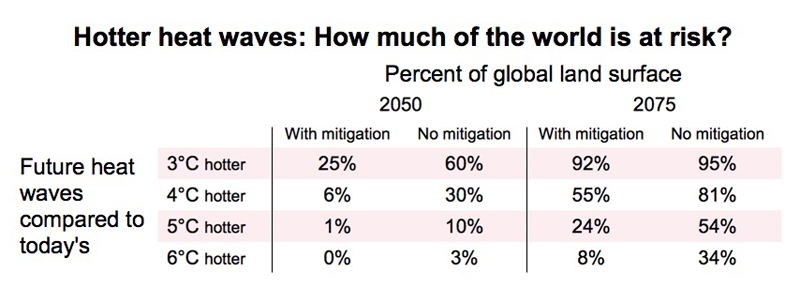Searing heat waves detailed in study of future climate
One-in-20-year events could become yearly across large swath of Earth by 2075
Feb 23, 2016 - by Laura Snider
Feb 23, 2016 - by Laura Snider
Sweltering heat waves that typically strike once every 20 years could become yearly events across 60 percent of Earth's land surface by 2075, if human-produced greenhouse gas emissions continue unchecked.
If stringent emissions-reduction measures are put in place, however, these extreme heat events could be reduced significantly. Even so, 18 percent of global land areas would still be subjected yearly to these intense heat waves, defined as three exceptionally hot days in a row.
These are among the findings of a new study by Claudia Tebaldi of the National Center for Atmospheric Research and Michael Wehner of the Lawrence Berkeley National Laboratory. The study, funded by the U.S. Department of Energy and published in the journal Climatic Change, quantifies the benefits society would reap, in terms of avoiding extreme heat events, if action is taken now to mitigate climate change.
"The study shows that aggressive cuts in greenhouse gas emissions will translate into sizable benefits, starting in the middle of the century, for both the number and intensity of extreme heat events," Tebaldi said. "Even though heat waves are on the rise, we still have time to avoid a large portion of the impacts."
Tebaldi and Wehner used data generated by the NCAR-based Community Earth System Model to study 20-year extreme heat events—those intense enough to have just a 1-in-20 chance of occurring in any given year. The model was developed with support from the Department of Energy and the National Science Foundation, NCAR’s sponsor.
The researchers looked at two things: how frequently today's typical 20-year heat wave may occur in the future, as well as how much more intense future 20-year heat waves will be.

Besides finding that today's 20-year heat waves could become annual occurrences across more than half of the world's land areas by 2075, the study also concluded that heat waves with a 1-in-20 chance of occurring during a future year will be much more extreme than heat waves with the same probability of occurring today.
For example, if emissions remain unabated, a heat wave with a 1-in-20 chance of occurring in 2050 would be at least 3 degrees Celsius (5.4 degrees Fahrenheit) hotter for 60 percent of the world's land areas. For 10 percent of land areas, a 20-year heat wave in 2050 would be at least 5 degrees C (9 degrees F) hotter.
A few degrees may not seem like much on a mild day, but during extreme heat events, they can mean the difference between life and death for vulnerable populations, Wehner said.
"It’s the extreme weather that impacts human health; this week could be 2 degrees Celsius hotter than last week, and that doesn’t matter," he said. "Now, imagine the hottest day that you can remember and instead of 42 degrees C (107.6 degrees F) it’s now 45 degrees C (113 degrees F). That’s going to have a dangerous impact on the poor, the old and the very young, who are typically the ones dying in heat waves."
By 2075, the situation is likely to become much more dire if greenhouse gas emissions—produced largely by the burning of fossil fuels—are not reduced. The percent of land areas subject to 20-year events that are at least 5 degrees C hotter swells from 10 to 54 percent.
However, if emissions are aggressively cut, the severity of these 20-year events could be significantly reduced over the majority of the world's land areas, though portions of the Earth would still face dangerous heat extremes. For example, in 2075, almost a quarter—instead of more than a half—of land areas could experience 20-year heat waves that are at least 5 degrees C hotter than today's. “But even with such dramatic reductions in carbon dioxide emissions, future heat waves will be far more dangerous than they are now,” Wehner said.
The researchers also looked at single-day extreme heat events, as well as single-day and three-day blocks when the overnight low temperature remained exceptionally warm. Past research has shown that human health is especially endangered when temperatures do not cool off significantly at night. All of these events had similar increases in frequency and intensity.
The fact that extreme heat events are expected to increase in the future as the climate changes—and the fact that emission reductions could ameliorate that increase—is not a surprise, Tebaldi said. But this study is important because it puts hard numbers to the problem.
"There is a cost attached to reducing emissions," Tebaldi said. "Decision makers are interested in being able to quantify the expected benefits of reductions so they can do a cost-benefit analysis."
Tebaldi and Wehner's paper is part of a larger project based at NCAR called the Benefits of Reduced Anthropogenic Climate Change, or BRACE. For the project, researchers from across NCAR and partner organizations are working to quantify how emission reductions may affect health, agriculture, hurricanes, sea level rise, and drought.
About the article
Title: Benefits of mitigation for future heat extremes under RCP4.5 compared to RCP8.5
Authors: Claudia Tebaldi and Michael F. Wehner
Publication: Climatic Change